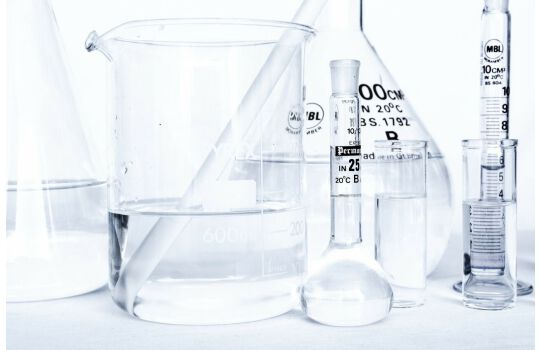HNO3
Nitric acid
63,01 g/mol
1,51 g/cm³
83 °C
-42 °C
Nitric acid (HNO3), also known as aqua fortis (Latin for "strong water") and spirit of niter, is a highly corrosive mineral acid. The pure compound is colorless, but older samples tend to acquire a yellow cast due to decomposition into oxides of nitrogen and water.
itric acid (HNO3), also known as aqua fortis (Latin for "strong water") and spirit of niter, is a highly corrosive mineral acid.
The pure compound is colorless, but older samples tend to acquire a yellow cast due to decomposition into oxides of nitrogen and water. Most commercially available nitric acid has a concentration of 68% in water. When the solution contains more than 86% HNO3, it is referred to as fuming nitric acid. Depending on the amount of nitrogen dioxide present, fuming nitric acid is further characterized as white fuming nitric acid at concentrations above 95%, or red fuming nitric acid at concentrations above 86%.
Nitric acid is the primary reagent used for nitration – the addition of a nitro group, typically to an organic molecule. While some resulting nitro compounds are shock- and thermally-sensitive explosives, a few are stable enough to be used in munitions and demolition, while others are still more stable and used as pigments in inks and dyes. Nitric acid is also commonly used as a strong oxidizing agent.
Contents
1 Physical and chemical properties
1.1 Contamination with nitrogen dioxide
1.2 Fuming nitric acid
1.3 Anhydrous nitric acid
1.4 Structure and bonding
2 Reactions
2.1 Acid-base properties
2.2 Reactions with metals
2.3 Reactions with non-metals
2.4 Xanthoproteic test
3 Production
3.1 Laboratory synthesis
4 Uses
4.1 Precursor to organic nitrogen compounds
4.2 Use as an oxidant
4.3 Rocket propellant
4.4 Niche uses
4.4.1 Analytical reagent
4.4.2 Woodworking
4.4.3 Etchant and cleaning agent
5 Safety
6 History
7 References
8 External links
Physical and chemical properties
Commercially available nitric acid is an azeotrope with water at a concentration of 68% HNO3, which is the ordinary concentrated nitric acid of commerce. This solution has a boiling temperature of 120.5 °C at 1 atm. Two solid hydrates are known; the monohydrate (HNO3·H2O or [H3O]NO3) and the trihydrate (HNO3·3H2O).
Nitric acid 70%
Nitric acid of commercial interest usually consists of the maximum boiling azeotrope of nitric acid and water, which is approximately 68% HNO3, (approx. 15 molar). The density of concentrated nitric acid is 1.35 g/cm3 (68% conc). This is considered concentrated or technical grade, while reagent grades are specified at 70% HNO3. An older density scale is occasionally seen, with concentrated nitric acid specified as 42° Baumé.[5]
Contamination with nitrogen dioxide
Fuming nitric acid contaminated with yellow nitrogen dioxide.
Nitric acid is subject to thermal or light decomposition and for this reason it was often stored in brown glass bottles:
4 HNO3 → 2 H2O + 4 NO2 + O2
This reaction may give rise to some non-negligible variations in the vapor pressure above the liquid because the nitrogen oxides produced dissolve partly or completely in the acid.
The nitrogen dioxide (NO2) remains dissolved in the nitric acid coloring it yellow or even red at higher temperatures. While the pure acid tends to give off white fumes when exposed to air, acid with dissolved nitrogen dioxide gives off reddish-brown vapors, leading to the common name "red fuming acid" or "fuming nitric acid" – the most concentrated form of nitric acid at Standard Temperature and Pressure (STP). Nitrogen oxides (NOx) are soluble in nitric acid.
Fuming nitric acid
Main article: Red fuming nitric acid
A commercial grade of fuming nitric acid contains 98% HNO3 and has a density of 1.50 g/cm3. This grade is often used in the explosives industry. It is not as volatile nor as corrosive as the anhydrous acid and has the approximate concentration of 21.4 M.
Red fuming nitric acid, or RFNA, contains substantial quantities of dissolved nitrogen dioxide (NO2) leaving the solution with a reddish-brown color. Due to the dissolved nitrogen dioxide, the density of red fuming nitric acid is lower at 1.490 g/cm3.


